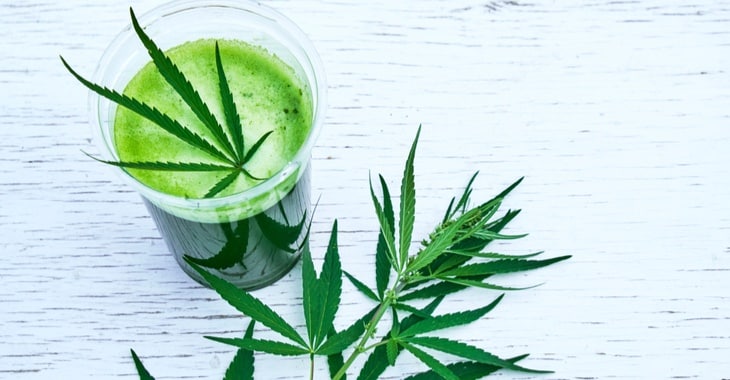Consumers now have increasing access to a multitude of cannabis products ranging from topicals to concentrates. Juicing, which has gained massive popularity within mainstream culture, has now begun making headway in cannabis culture as well. So, how does juicing differ from other delivery methods?
One of the biggest ways in which juicing cannabis stands out from the pack is the lack of THC; the primary psychoactive molecule in the cannabis plant.THCA, the acidic form of THC, becomes decarboxylated (forming THC)when heated, or over longer periods of time. On a chemical level, THCA targets CB2 receptors outside of the brain and central nervous system. [1] For example, a recent study has found that THCA was highly effective in treating nausea and vomiting. [2] THCA has also been shown to successfully regulate endocannabinoid function, as well as reduce inflammation, a major source of pain for many patients. [3] So,in other words,juicing cannabis allows users to take advantage of the medicinal benefits of the plant without getting high.
Similarly, juiced cannabis contains someCBDA, the raw form of CBD. According to previous studies, it has been found that CBDA acts as a COX-2 inhibitor, which means it reduces inflammation in a way similar to ibuprofen and aspirin. However, as of today, the number of dedicated CBDA-focused studies have been limited.
Although CBDA has different molecular targets than THCA, it has proven the ability to combat nausea and act as an anti-depressant.[1]On top of the benefits of both THCA and CBDA, the cannabis plant, as a whole, is rich in calcium, potassium, phosphorous, iron, zinc, and a host of other nutrients.
In lieu of the lack of quality research on the benefits of juicing cannabis, much remains to be seen. However, the research and testing that does exist has shown promise. We can only wait and see what other benefits the cannabis plant has in store for us.
References:
- Andre, C. M., Hausman, J. F., and Guerriero, G. “Cannabis sativa: The Plant of the Thousand and One Molecules”.Frontiers in Plant Science. 2016;7(19): 4-5 [Times cited = 32, Journal impact factor = 4.98]
- Rock, M., et al. “Tetrahydrocannabinolic acid reduces nausea‐induced conditioned gaping in rats and vomiting in Suncusmurinus“.British Pharmacological Society. 2013; 170(3): 641 [Times cited = 6, Journal impact factor = 6.81]
- Izzo, A. Angelo, et al. “Non-psychotropic plant cannabinoids: new therapeutic opportunities from an ancient herb”. Trends in Pharmacological Sciences. 2009; 10(30): 525-526 [Times cited = 100, Journal impact factor = 12.108]
Photo courtesy of Farma Health












